








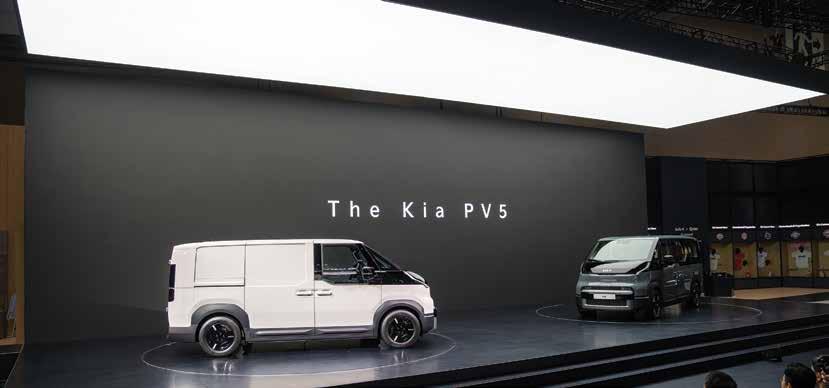
Seoul, Soul and Sole, three words, sound similar but with different meanings, yet somewhat connected. Seoul, the capital of South Korea, is the home of Kia, while soul is the sensation or emotional and intellectual energy surrounding the brand. The other sole being an owner driver, one element of the customer base that will be targeted with the introduction of the new PBV range of electric light commercial vehicles.
As the abbreviation PBV means Platform Beyond Vehicles, this new venture into the van world by Kia is not just about vehicles. It’s a new concept with new ideas, new solutions and services. Inclusion and accessibility for moving people and goods in a different and sustainable manner, is its way forward.
The whole project, three years in development, is a big investment by the Hyundai Group owned brand and sees the PBV enter a very competitive global commercial vehicle market that turns out over 4 million units per year.
in the next few years. A totally new multi-story, eco-friendly factory has been built near Seoul, and the first prototypes of the PV5, a midsize van and passenger carrier have been produced. This July will see the manufacturing facility in full swing. Partnerships with big fleet operators such as express logistics specialists DHL and Korean electronics giant LG are already in place.

Product development is centred around the foundation stone, the group’s E-GMP.S platform upon which all variants, (up to fourteen small, medium and large versions including body conversions) will be constructed. There will be three cargo vans, the PV5, PV7 & PV9, four people carriers and seven conversions, all available to order from the factory when fully up and running.
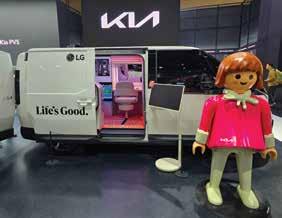
Kia’s objective is to reach an annual sales target of 250,000 units annually, based on a seven model range to be introduced
Such is the confidence in the new PBV ideal, Kia is offering an extendable warranty from 7 years/160,00 km to 10 years/200,000 km as an add-on peace of mind package. Among the other services provided, which were mentioned during an exclusive International Van of the Year jury event in Seoul, these include the provision of electric vehicle charging stations, an eLife Business package, fleet management and software systems and an aftermarket call centre. Retail sales will be conducted through Kia’s dealer network, many of which are multi franchise holders with light commercial vehicle sales and service expertise. Ireland will have six appointed dealers nationwide initially.
According to Akshit Khosla, Manager Advanced Planning + PBV, design of the
PBV has many merits including a smooth driving experience, quick charging, connectivity including over-the-air upgrades, best in class low loading height, 3-piece front bumper and extended warranty. He mentioned that the PV5 is a C segment van, with a 2/3 seat option, competing with the likes of the Peugeot Partner and Volkswagen Caddy, but due to its larger 4m3 load volume it can take on the challengers in the B segment. Classified as N1 in EU homologation terms, the cargo version is set to achieve 75% of its sales, with 25% directed towards the M1 MPV people carrier, which can offer 5/6 or 7 seats with different configurations inside.
N1 Kia PV5 Cargo
Power: 43.3 kWh/51.5 kWh/71.2 kWh
Range: 240 km/ 300km/400 kmestimated
Payload: 735 kg/ 790 kg/ 690kg
m1 Kia mPV
Power: 51.5 kWh/71.2 kWh
Range: 288 km/400 km - estimated Payload: 735 kg/ 790 kg/ 690kg
seat configurations: 5-seat = 2/3/0, 6-seat = 1/2/3, 7-seat = 2/2/3 with 85o rear opening tailgate.
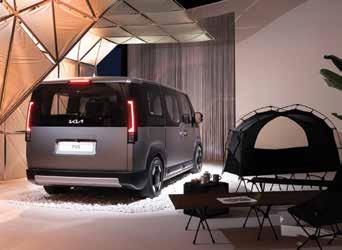
At the Seoul Mobility Show 2025, Kia had a special exhibition theme: ‘Innovative Mobility Life provided by Kia’, where its large stand was divided into themed zones, including the PV5 Zone, Tasman Zone, EV Lineup Zone, and Kia Connect Zone. These zones offer visitors a hands-on experience of Kia’s next-generation vehicles and mobility innovations. The PV5 Zone featured the Cargo, Passenger and its innovative WAV (Wheelchair Accessible Vehicle) –enabling inclusive mobility for all To further illustrate its vision, Kia created the PV5 Town in collaboration with global toy brand Playmobil, visualising real-life mobility use cases including logistics and accessible transport. Also featured were PV5 concept models co-developed with LG Electronics, including:
n spielraum studio: a mobile office equipped with LG’s AI-powered appliances
n spielraum Glow Cabin: designed for outdoor leisure, featuring built-in refrigerator, microwave oven, and wine cooler
Kia also presented its Kia AddGear platform, for customisable in-vehicle modules, and Kia e-Life Package Biz, a suite of tailored EV solutions for corporate customers, including infrastructure consulting and charging services.
Among the show stoppers was the all-new Kia Tasman WKNDR Concept, with the tag line “Built for Adventure”. Based on its upcoming Tasman pickup it’s designed for adventure seekers and outdoor lifestyles, and features 35-inch all-terrain tyres, wider wings, integrated accessory rails, and enhanced cargo solutions. The Tasman Zone also included the ‘standard’ model, the off-road-focused X-Pro variant, with lifestyle gear displays showcasing Kia Genuine Accessories and Tasman Collection merchandise, including 1:10 scale models. Tasman is not on sale in Europe…as of yet.
“Kia demonstrated its vision for future sustainable mobility through innovative solutions such as the PV5 and Tasman,” said a show spokesperson at Kia. “We are committed to creating and delivering differentiated technologies, cutting-edge designs and flexible features that cater to our customers’ diverse lifestyles and business needs.”
Lots of facts and figures were outlined during the executive factory tour. o f the factory visited - one of four main plants near Seoul, almost 520,000 units are assembled, with 60% of these models exported to 170 countries around the world. A further 3.68 million units are produced from Kia’s other five plants globally. This July will see the ramp up of production of the new PV5 and Tasman in a totally new multipurpose, highly advanced manufacturing facility. on a walk around tour involving numerous lanes and elevated floors, the scale of the
facility impressed, from the Stamping area where the body panels are pressed to Welding, where 280 robots are engaged. o ther sections include Painting, again automised, Assembly, where near to 2,000 parts are put together, and finally Inspection, which includes quality controls and random test drives on its vast Proving Ground nearby.
From bicycles to the T600 three wheel pick up mopeds to the fully electric, connected PV5 van, Kia has

come a long way in the past eighty years. Progressing from initial producing bikes and scooters saw the fledgling company assemble cars and commercials under licence from other manufacturers, Kia Industries began to venture into light commercials in 1952 with the Bongo van and minibus. There was also the Brisa and Ceres wearing the Kiamaster badge. Actually its first electric van was produced back in 1993. It had a 100km range and even had solar panels on the roof, which added 16km to the emission free distance.
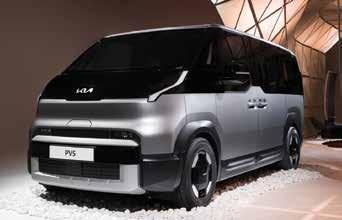
In1987 Kia launched its first car, the Pride, a compact car which went on to sell over 1 million units. A stronger vote of confidence in its products was promoted with the introduction of the landmark 7-year warranty, which has remained as a major selling point ever since.
A brief inaugural drive in the PV5 on the Proving Ground was worthwhile to get an insight to how this new entry into the light commercial vehicle market may fare. Very well, is our considered opinion. Certainly it augers well for Kia’s future in the eLCV market. We look forward to a full test drive experience somewhere in Europe in due course.

Are you pleased with the progress of, and reaction to Kia’s entry into the Light Commercial Vehicle market with new electric vans?
Yes, we are very pleased. our return to the LCV market was shaped by stricter environmental regulations, digitalisation, and advancements in software technologies, like AI. Despite these changes, we saw this as the right time to introduce Platform Beyond Vehicles (PBVs). our dedicated EV platform is built and tested for B2B usability. This is our USP in combination with the ecosystem of dedicated connected services, FMS, conversions, and so on.
Businesses today need tailored mobility solutions but face common challenges like compromised quality and safety in low-cost models, limited electrification options, inefficiencies in vehicle conversion, and a lack of digital compatibility. Kia is taking a fresh approach to meet the evolving demands of business customers by offering connected services that enhance efficiency and customisation.
When will we see production models on sale?
The PV5 is set to go on sale in Korea and Europe in the second half of this year, with pre-orders expected to begin in the first half of the year for these markets. Sales in other global markets, including the ASEAN and MEA regions, in 2026. To support a diverse range of business applications, conversion models will enter production sequentially between 2025 and 2026.
What is your immediate sales strategy? We anticipate commencing pre-orders for the Korean and European markets in the first half of this year. More than 60% of Kia dealers already have experience in LCV sales, so we are selecting dealers mainly within the Kia network. However, we are also looking at specific LCV Centres.
We will establish dedicated PBV Centres to provide professional and high-quality services specifically tailored for PBV customers. We wish to build long-term relationships based on trust in Kia
- Ho Sung Song; President & CEo Kia, Marc
President & CEo, Kia Europe, with Jarlath Sweeney, Chairman, International Van of the Year jury.
products and the brand. We aim to establish 640 PBV dealerships in Europe by 2025 and also recruit external dealers to expand coverage and expertise. We will offer various versions of the PV5, including the Cargo Van and Passenger Van. Additionally, conversion models for specialised business applications will enter production between 2025 and 2026. The indicative pricing for the PV5 Cargo Van entry model is expected to be €35,000 (€30,000 excluding VAT), and €40,000 for the Passenger Van. We have identified this as the right price range to compete in TCo with the entire C-segment while still bringing the novelty of a dedicated EV platform and connectivity.
Do you think it will be challenging to convert new customers who are loyal to current brands?
Yes, we anticipate that it will likely be challenging to convert new customers who are loyal to other brands. However, we aim to convince new customers by positioning our PBVs as business platforms.
our PBVs offer USPs like a dedicated EV platform with up to 20% more cargo and loading capacity compared to traditional models, flexible space configurations through modularisation, V2X connectivity, an optimised TCo, a comprehensive and reliable PBV ecosystem, ultra-fast charging (10 to 80% in <30 minutes), versatility in B2B applications. For business customers, a low TCo will be attractive, and on top of that, minimum downtime, efficient fleet operation, and more value. We have been incorporating this into our PBV line-up since day one. Customers exercise dealer loyalty, and they look, first of all, for what’s important to them: uptime and ease. So, if we have the right network and the right quality, they can make the switch seamlessly. Will you initially target Kia car customers who operate vans?
We are targeting all B2B customers. To introduce PBVs, we plan to leverage our existing global sales and service network, which includes dealerships that already serve Kia owners. We are in the process of developing a specialised
PBV Customer Experience Journey (CXJ) tailored to B2B customers. This will not be limited to Kia owners.
our main goal is to establish a strong presence in the overall LCV market and specifically target B2B customers with our PBVs.
How will you market and promote the Kia PBV range in Europe?
Kia will market its PBV range by emphasising its USPs: dedicated EV platform, offering greater cargo capacity, flexibility, and advanced tech like AI and V2X connectivity. We will highlight competitive TCo, targeting B2B sectors such as logistics and mobility services, with partnerships like Uber showcasing real-world applications.
We can reassure businesses with our strong service network, including PBV Centres and fast parts delivery. We will also position the PV5 with competitive pricing and promote its modular design for versatile commercial use. on top of that, we will also join trade associations and attend roadshows for even more reach.
Regarding trade shows and exhibitions, you will have a presence at the CV Show in Britain and also at Solutrans in Lyon. What else is planned? In our eyes, Solutrans will remain the most important event of the year. We will definitely be attending the CV Show for our PBV launch in the U.K. For the remainder of the year, we plan to attend 19 events, including the Convertors Show, the PBV Conference, and IAA. Additionally, we will be present at several local events, such as the Poznan Motor Show, which is important not only for Poland but also for all of central Europe. We will continue to exhibit the PV5 wherever possible, whether at dealer events or trade fairs.
With a factory output capacity of 250,000 units, how long do you think it will take to reach this figure? By 2030, we will have already launched the PV7 and the PV9. Within those five years, our goal is to achieve 250,000-unit sales of our entire PBV line-up.
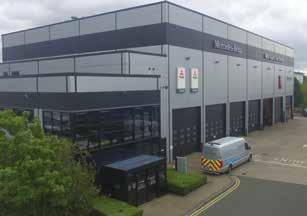


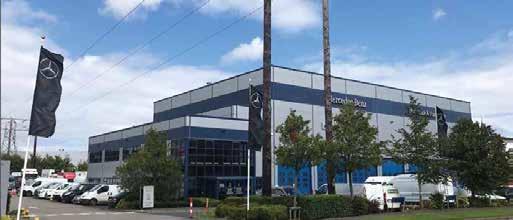











Renault goes back and forward to introduce new Van line-up: Trafic, Estafette and the Goélette
Van model names such as the Estafette and the Goélette may not immediately roll off the tongue, but they soon will, as the Renault Group has just reintroduced these badges from yesteryear commercial vehicles into a new range of vans.
The Commercial Vehicle Show 2025 provided the stage setting for the launch of the French brand’s latest arrivals, but with a difference.
What difference? Well, the new Estafette and Goélette, along with the new generation Trafic are based on what has been created by a start-up company. Flexis was formed to design, develop and manufacture a new generation of all-electric commercial vans and to deliver fleet management solutions, based on software defined vehicle (SDV) architecture. An independent company, Flexis was formed through a joint venture between Renault Group, Volvo
Group and CMA-CGM Group.
Earlier this Spring, at a special launch event in Paris, Flexis revealed the prototype vehicle series, namely the Panel Van, Cargo Van and Step-in Van, which in turn will be marketed, sold and serviced by Renault Pro+ as the Trafic, Goélette and Estafette. In addition to the Renault Pro+ products, the Renault Trucks’ network will also sell the new range under the Red Edition banner.

As the trio of new vehicles highlights, the Flexis-developed all-electric skateboard platform is adaptable to a variety of body styles. The aim is to deliver a broad capacity for customisation to meet all the needs of business users.
For the record, the Estafette was a Renault van from the 1950s, while the

Goélette wore both the Saviem and Renault badges from the 1950s -1980s.
An early pioneer of 100% electric commercial vehicles with the Kangoo Zero Emission (ZE) 15 years ago, Renault has always maintained an innovative, business-oriented approach to its range dedicated to professionals. In fact, the Kangoo Z.E. was the first electric van to win the coveted International Van of the Year Award (IVoTY) in 2011.
More recently, the latest Renault Master also claimed the IVoTY honour for 2025, thanks to its sleek, aerodynamic “Aerovan” design concept, and this model will continue to be sold alongside the new family of electric vans.
The design concepts behind the body shapes and styling of the new Trafic, Goélette and Estafette are aimed at optimising load capacity in relation to footprint. Hence they have minimal
front overhangs and rear-mounted powertrains, with the battery packs located underneath. In fact, all three vehicles have a turning diameter similar to that of the Clio (10.3 metres).
For greater operational usage, the Trafic, Goélette and Estafette E-Tech offer a choice of two battery options: standard range and long range. For high-mileage drivers, the long range battery with NMC (nickel manganese cobalt) technology is said to deliver the highest energy density, providing for a maximum range of around 450 km WLTP (Trafic). For business users working primarily in urban areas, the standard range battery uses LFP (lithium Iron phosphate) technology, free of rare metals such as cobalt and nickel for a competitive offer in terms of price and autonomy. With nearly 350 km WLTP range available (on Trafic), this battery will meet the needs of most operations.
Available with 800V technology for the first time, these vehicles can power-up from 15 to 80% in under

Building on this pedigree, the fourth generation all-electric model, based on the Flexis Panel Van marks a revolutionary change.
Built on an EV skateboard platform, with an underfloor battery and rear-mounted powertrain, the L1 Trafic van has a load capacity of 5.1 cubic metres from a length of 4.87m and a width of 1.92m (identical on all three vehicles). The L2 van has a load capacity of 5.8 m3 from a length of 5.27m, with a wheelbase that is 40 cm longer. At the same time, overall height has been reduced to 1.90m, ensuring access is possible to all underground car parks.

20 minutes with DC fast-charging technology. With 150 kW and 345 Nm, the new electric motor, designed in Europe, stands out for its high efficiency: 95% of the electrical energy is transformed into mechanical energy.
originally launched in 1980, the Renault Trafic can be termed as a ‘great all-rounder’. o ver 2.5 million units across three generations have been built and sold. Its name has become synonymous with success in the medium LCV market segment.
What is noteworthy about the Trafic IV’s frontal design is that the front light strip incorporates the brand’s identity. As a result, it marks the end of the Renault diamond emblem in chrome. Indeed, new Trafic is also the first Renault to receive a rear light signature, sculpted in 3D. A trend for the future?
Yannick Bignon, is the LCV Design Director at Renault, and has adopted a refreshing and different approach to the interior design. It features a tube-shaped dashboard running from one side of the cabin to the other, with two screens: a 10” instrument cluster and a 12” central screen facing the driver in between.
Storage is a key part of the everyday experience for business users, and
Trafic meets this need with an array of generously sized compartments. As well as a closed glovebox, there are a number of open but suitably partitioned compartments: three cupholders and a document holder under the central screen. Additionally there are three storage areas behind the instrument cluster, two small cubbies on either side of the steering wheel, a deep shelf under the ‘tube’ on the passenger side, and two levels of storage in the doors, the highest for small items and the lowest for bulky objects, such as bottles of water. Behind the dashboard, between the ‘tube’ and the base of the windscreen, a vast area is provided for the secure storage of all sorts of objects, such as a notebook, a jacket or a pad.
Sharing the same platform and cab as the Trafic E-Tech, the Goélette E-Tech stands out for its load capacity and cargo space. Thanks to its reinforced axles, it can carry loads of up to 1.4 tonnes, enabling it to be customised, with conversions carried out in the factory and by Qstomize or its network of certified bodybuilders.
In the past the Renault Goélette LCV was tough, robust and easy to convert. It was one of the most versatile vans for self-employed people or small businesses with specific requirements. Directly derived from the Trafic van, from which it takes its dimensions and cab design (exterior and interior), Goélette takes full advantage of the flexibility of the “skateboard” platform to offer several different ‘factory’ versions, such as, for example, a chassis cab, a high-volume box or an extended cab.
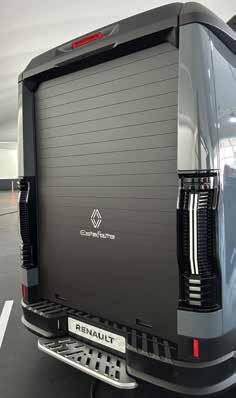
The chassis can be fitted with a large-volume box body that can exceed 10 m3, while the deep cab, which combines transport for up to 6 people with ample loading space, will also be assembled on the main production line, like the other conversions.
Estafette E-Tech closely resembles the concept panel van of the same name unveiled last September, at the IAA Transportation Show in Hannover. It is what the express/last mile delivery specialists have been waiting for. Its name is a tribute to the Renault van that revolutionised its market segment in 1959, adopting a front-wheel-drive layout at a time when passenger cars were still rear-wheel-drive. o ver half a million Renault Estafette vans were built between 1959 and 1980.
Although its height sets it apart from Trafic, Estafette nevertheless shares the same skateboard platform. Estafette is tall at 2.60m, allowing a delivery driver to stand upright inside the vehicle.. Available in one length of 5.27m, Estafette features a load capacity of 9.2 m3.
A unique feature of the Estafette compared to the other two variants is that it comes with sliding side doors
and a rear roller shutter. Additionally it is possible to walk through from the cabin to the load area, and to make the work of delivery drivers even easier, the outside handles are designed to be opened with the elbow alone, so drivers can keep a firm grip on parcels. The tube-shaped dashboard running the width of the cab is the same as on Trafic and Goélette. The only difference is that it is 20 cm higher with a simplified lower layout, mainly in order to create additional storage space to the right of the driver. At a delivery stop, when the driver presses a button on the lower dash, the interior door opens automatically, and the exterior hazard lights come on.
According to Antoine Vuillaume, SDV Programme Director at Ampere, the SDV (or Software Defined Vehicle), is a technological breakthrough. Software is no longer limited to certain functions, but is central to the entire vehicle. This centralised software architecture can be updated throughout the life of the vehicle, in the same way as a phone or a laptop.
“The vehicle is equipped with supercomputers, operating in the same way as a brain with two hemispheres. The right hemisphere manages the interfaces with the driver, i.e. infotainment, apps, voice control, 3d browsing and sign recognition. The left hemisphere is the vehicle’s nervous system, controlling all the actuators for the various functions, from braking to locking, as well as storing the data supplied by the sensors.”
Vehicles with specific functions, such as refrigerated vehicles, ambulances or other converted versions will also be able to make full use of the intelligent SDV architecture. on refrigerated vehicles, for example, the cold chain will be maintained as part of a predictive approach, based on highly detailed, real-time information such as the outside temperature and actual electricity consumption of the vehicle. If necessary, an additional charge will be scheduled to maintain the cold chain.
The central software is cloud-connected and can be updated remotely and in real time. Just like on their computer or smartphone, professional customers will be able to “upgrade” their vehicle by adding new functions such as vehicle and driver performance in real time. Already available on existing vehicles,
predictive maintenance is becoming even more important and precise, thanks to SDV. For instance, it will be possible to track the wear of some parts and to identify failures in real time. Diagnostics will be carried out remotely. This will make it possible to plan for repairs or correct faults directly. This feature will be particularly useful for fleet managers, allowing them to optimise costs, as well as vehicle uptime and availability.
Supported by SDV technology, the Trafic, Estafette and Goélette also house a new-generation openR multimedia system equipped with a 12-inch screen and evolved for light commercial vehicles. Featuring the largest screen in the Renault LCV range, for example route planning will take into account particulars such as the vehicle’s dimensions and load to avoid unsuitable
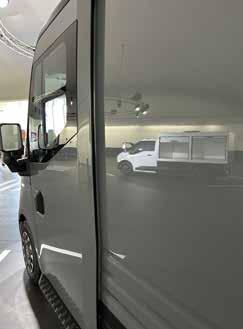
routes. In this way, the on-board electric route planner provides the best itineraries, suggesting recharging stops thanks to enhanced consumption accuracy. Google Automotive services, including Google Assistant and Google Play, will also be available, enabling drivers to interact intuitively with their vehicle to manage the temperature, take notes, control the radio or request the latest news or weather.
Trafic, Goélette and Estafette will all be built at the Renault Group plant in Sandouville, France. They will be built alongside the Trafic ICE, which is continuing in production.

Moving your business. Coming soon.

We can at this stage say that electric vehicles work well overall for the social and domestic user. When going on a longer journey you simply have to factor in leaving earlier and allowing time to charge on the way. That luxury however is not readily available for the commercial van user, because when the customer calls the van needs to deliver without delay.
one solution offered by Ford Pro as a bridge between the internal combustion engine and the full battery electric is the Transit Custom - Plug-in Hybrid Electric Vehicle (PHEV). The great advantage of the Custom PHEV lies in its versatility and that it will work for just about any type of application, while the extended

electric driving range of the PHEV when compared to a regular Hybrid helps to save fuel and therefore emissions. The Transit Custom PHEV uses Ford’s 2.5 litre Duratec petrol engine that primarily charges the 11.8 kWh lithium-ion battery to power the single electric motor, giving a total power output of 233 PS and 209 Nm of torque.
The PHEV Custom is the same well known and well-regarded front wheel drive light commercial that is hugely popular in diesel form, and comes with the same dimensions - all that has changed is the powertrain. Arguably this new driveline makes the van more pleasing to drive, as it is smoother, quieter on electric mode and more responsive to moving off. The quiet
operation is also well suited to low noise and silent operation zones, and electric only propulsion can be selected using the ‘Now’ driving mode. Pure electric running is possible for up to approximately 57 kms. In addition there is a ‘Later’ mode - this uses the combustion engine and keeps the battery power to use later, while in the ‘Auto’ mode the vehicle switches between electric and petrol as it sees best fit.
Ride and handling are comfortable, and the steering is accurate with a good turning circle - a feature always helpful with urban deliveries. Braking is well balanced and nicely progressive, and the regenerative braking is easy to manage and quickly becomes part of the driving style, helping to maximise the possible efficiencies from the vehicle. The regenerative braking is especially powerful when the ‘L-Mode’ is activated. L-Mode dramatically increases braking force and therefore regeneration, and when used to its full potential it is possible to engage in a one-pedal driving style. This can be seen in the on-board display that clearly shows what mode the Custom is operating in at any moment. The on-board display also helps to promote a good driving style with some ongoing ‘Coaching Tips’ that are useful especially at the start.
The cabin is perfectly functional with good visibility for the driver and is comfortable. It has evolved to become far more car like than previous, and is
fully equipped with the required features for a modern day’s work. These features include charging ports, cup holders and an impressive 13” infotainment display with Apple/Android Car Play. There is a good range of adjustment from both the heated seat and steering column ensuring just about every size of driver can get comfortable, and we feel everyone will become quickly accustomed to the slightly square steering wheel.

It can be hard to find serious fault with Ford’s Transit Custom in this PHEV model, and what we are simply looking at here is the application of an electric driveline to an already highly popular van that has widespread appeal. It can certainly bridge the gap between combustion engines and a full electric,

especially where an operator may be hesitant to make the move to a full BEV. There are few areas of operation where the PHEV will not perform well.

The eDeliver 5 is the fourth model in Maxus’s family of eDeliver electric vans, slotting in between the eDeliver 3 and eDeliver 7. As such it falls somewhat between what would be considered the traditional compact and medium sized van categories, a flexibility that can make it appealing to customers of either.
Externally it’s quite visually distinctive with its high mounted headlights and separate lozenge-shaped brake and reversing lights at the rear. It’s fairly clear that Maxus sees the Volkswagen ID. Buzz as one of its main rivals and certainly it attracted more glances from other road users than you would normally get in a white van.
o ffered in two variants with differing body heights, the eDeliver 5 comes with the same payload capabilities of 1200kg as that offered by the eDeliver 7 (the eDeliver 3 can carry 1045kg). on the load volume side it slots in between the other two, its 6.6 cubic metres for the L1H1 version and 7.6m3 for the L1H2 model comparing to the 4.8m3 of the eDeliver 3 and the 8.7m3 of the eDeliver 7. That 6.6m3 compares well with the ID. Buzz Cargo’s 3.9m3, and is similar to that available on Ford’s e-Transit Custom L2H1 model.
The cargo area is 2,654mm long and 1,704mm wide, with respective heights for the H1 and H2 bodies of 1,455mm and 1,675mm. The rear barn doors open in a one third / two thirds split, while the eDeliver 5 comes with sliding doors on each sides as standard. Inside there are four tie-down points. A useful 1.5 tonne towing capacity adds to its appeal.
Power comes from a 120kW / 163PS electric motor that develops 240Nm of torque. Electric energy is stored via a 64kWh battery that Maxus says will deliver up to 335km on a combined cycle (305km from the high roof model). As with all EVs expect real life running to be somewhat lower, but this figure is similar to that promised by the Ford
e-Transit Custom for example, and will be adequate to meet the needs of many operators or owners. Maximum accepted DC charging speed is 120kW. First impressions climbing inside are of a spacious and - for a van- rather stylish cabin. It’s a three seater with the middle seat offering reasonable space for an LCV of this size - provided you aren’t needing to use the foldout cupholders that open into the space where the passenger’s legs go. However spend a little time here and it becomes clear that it’s more form than function. Firstly there’s a dearth of physical controls with most, including heating controls being incorporated into the centre mounted 12.3” central display. A lack of storage space is the biggest issue though. There’s an overhead compartment and a netted areas in the doors that will hold a few small items. But there’s no glove compartment and other than the aforementioned cupholders that’s pretty much it.
Driving information is provided via a smaller screen in front of the driver, and equipment wise it’s not lacking with the likes of Apple CarPlay, adaptive cruise control, heated seat, rear parking sensors and 360 around-view system. It also comes with all the latest ADAS safety equipment fitted, enough to earn the eDeliver 5 a Platinum rating from Euro NCAP.
on the road the eDeliver 5 feels quite lively. Its speed is limited to 120km/h but it accelerates rapidly up to that speed, provided you’re not worried about
battery life. Ride is a little clunky over less well surfaced roads, but the steering is nicely weighted. There are three power regeneration settings controlled from the steering wheel, with the maximum setting giving almost one pedal operation. Visibility is quite good, but getting a comfortable driving position was a challenge for this driver at least, as the bulkhead meant the seat setting was too upright relative to the needed legroom.

With every model launched, Maxus has been drawing ever closer to the best the European van brands can offer and the eDeliver 5 is arguably its most complete product to date. Priced from €38,750 (ex-VAT and VRT), it offers an appealing price point for individuals or businesses looking for mid-sized electric LCVs. While the cabin is let down by a lack of storage space, it’s a pleasant space in which to spend time. The eDeliver 5 can compete with the best electric vans currently available for load carrying space and towing capabilities, while offering a decent range and rapid charging.

Ford Pro presented the latest models in the electric powered Transit family at a test drive event recently in Barcelona. The commercial vehicle division of the Ford Motor Company has added the E-Transit Courier and the Transit Connect PHEV to its line-up, alongside the award winning E-Transit Custom (Electric & PHEV) and E-Transit, with extended range distance. The occasion, while looking to the future, also reminisced about the past, as examples of original Ford Transit models were on display, marking 60 years of the iconic van.
But it’s not all about producing hardware these days at Ford Pro, which, by the way stands for Ford Productivity, as the Transit team have created a number of connectivity software packages, designed to get the best and the most out of the vehicle, thereby maximising uptime and providing useful feedback to the driver and owner.
As well as the driving experiences, attendees had the opportunity to hear how some Ford E-Transit customers are progressing with the new zero emission technologies, and also chat with Ford Pro’s fleet management specialists about these extended services.
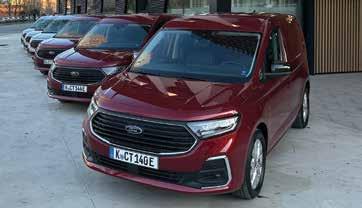
A LL -E LECTRIC Co URIER
E-Transit Courier, based on the second generation of the compact van which is larger than the original version, shares its platform and electrical developments with that of the Ford Puma Gen-E electric, also just launched.
A 100kW e-motor produces 136hp and 290Nm of torque, and combined with a 43kWh battery pack, up to 300 kms can be achieved, aided by a 120km/h speed limiter. Behind the driver, there is no real compromise either as it has a 700kg payload and can tow up to 750kg. The load area or load volume is not affected either, as in theory two Europallets can be carried, although the bulkhead does protrude a bit into that space. Long items can be slotted in through a flap in the bulkhead, which is handy.
It was interesting to discover that findings from a survey taken from Ford Pro connected vehicle data reveal that the E-Transit Courier’s 300km EV range meets the needs of 86% of its compact van users, who cover less than 200km daily.
A good two and half hour drive out in the Catalonian countryside provided a stern test for the electric Courier. No issues on the open road, as it sailed on smoothly but there was a little understeer when encountering the mountain passes towards La Finka. on average E-Transit Courier is said to return 17.1 kWh/100km.
Charging time varies whether it’s the fast (DC) or domestic (AC) systems used. With the 100kW DC, it takes just 23 minutes to bring the battery from 10% to 80%, while it’s an overnight job for the 7.4kW household charger.

Two versions of the new Transit Connect PHEV were driven next, the first the standard panel van, the other being what’s called the Flex cab, which effectively is a 5-seater crew cab that comes with an ingenious fold up rear bench seat, to allow for more load space when needed. What also is on offer with this version, specified in either SWB or LWB is a petrol-electric plug in hybrid, that has a low carbon footprint, electric power range of up to 117km, a 760kg payload and can tow up to 1,500kg. As this model is based on the Volkswagen Caddy, all of the features are akin to the German product except for the badging, of course. The 1.5-litre petrol engine, combined with the 19.7kWh battery and the automatic box works seamlessly, effortless in fact. As with the electric Courier, an 8-year/100,000 km warranty is offered. The Connect is the next Ford LCV due for electrification but that development is down to VWCV, all in due course.
The (2-tonne) E-Transit is the standard bearer and best-selling large electric van, with 46% market share in Europe last year. Andrew Mottran, E-Transit Chief Programme Engineer, provided further details of the ‘enhanced’ version which now
offers up to available from the 89kWh battery pack. Fast charging can be done in 28 minutes and it now comes fitted with an integrated heat pump which saves energy. Also standard is a 2.3kW Pro Power outlet. There are almost twenty different model types available, covering different applications with varying payloads.
Hans Shep, General Manager, Ford Pro Europe, emphasised the holistic, eco-system offered by Ford Pro through its broad connectivity system. This includes fleet management, preventative and predictive maintenance, over the air updates, and a very responsive Call Centre. Every customer case is carefully monitored and reacted upon, and provides an invaluable database from which to pinpoint and resolve issues if and when they arise.
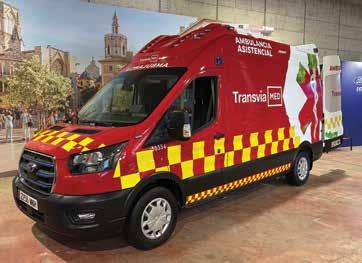
Those that take up the telematics package, for instance, benefit from improved overall operational efficiency and compliance. That goes for all the drivetrains available under the Ford Transit banner. For existing customers that are considering the move towards electric, Ford Pro’s EV Assist package brings them on the journey to zero emission transport. All business cases are catered for, from the tradesperson to the fleet owner.
Leading into the customer demonstration area were two fine examples of the first Transits from 1965, pristinely restored and ready to go on tour to commemorate six successful decades of the model. Inside the building a selection of vans from key fleet

customers from around Europe were gathered to highlight how they have adapted to daily electromobility. There was a Welsh honey producer and retailer with a number of E-Transit Customs, while a Spanish converter IndusAuto has supplied an Ambulance to Transvia Med, which manages well with this zero emission application. Spanish coffee supply company Eboca, was another one, confidently singing the praises of the 2-tonne electric Ford van, as was German roofing specialist Hunhold. Even a number of Ford Transit Centres Mobile Service units are E-Transits. In Ireland and across Europe, the DPD Group is one of the biggest operators of the E-Transit.


It has now been a number of months since Storm Éowyn, and there was a sense of calm at the ESB Networks Branch Headquarters in Athlone when Fleet Transport visited. The National Emergency during that major event and its aftermath was dealt with in the most efficient way possible, with ESB Networks employees working all hours to rebuild and reconnect power lines throughout the affected areas. All available hands were on deck from the Semi-State electricity network operator, with welcome assistance also provided by experienced network technicians from Austria, Finland, France, Germany, Northern Ireland, Norway, UK and Irish contract partners. Additional commercial vehicles, equipment and forestry specialists had to be drafted in to meet the huge demand to reconnect power to industrial, commercial and household premises.
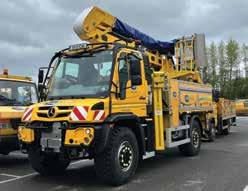
While storms of this nature and extent are rare occurrences, the consequences are severe and even dangerous, requiring a rapid response. That entails having a large selection of purpose built vehicles on hand, together with fully trained drivers and operatives and a broad range of equipment and fittings. Ensuring that response teams are properly equipped and fit for purpose means that a constant vehicle renewal programme is in place. That ranges from regular upgrading and refurbish-
L-R: James Jones, National Fleet Service Manager, ESB Networks; Martin Convey, Fleet Asset Manager, ESB Networks and Neil McGuinness, Fleet & Equipment National Services Manager, ESB Networks.
ment of the fleet to keeping up to date with regulation changes and training schedules, not to mention ensuring that safety is paramount in all operations and applications.
As well as all these aspects involved in the day-to-day running of the nationwide division within the ESB Group, the team of fleet engineers and managers at ESB Networks are also looking towards the future. In the short term that includes an ongoing transition towards zero-emission transport. For state companies like ESB under the Government’s Climate Action Plan there is a target of 38.5% of all new light goods vehicles purchased to be zero emission, however ESB Networks has set a more ambitious target to achieve 80% of all new light goods vehicles purchased to be zero emissions by 2030.
Currently, ESB Networks has over 2,300 vehicles in its fleet of which 2,000 are light commercials/o ff-road 4x4s, with the remaining 500 units comprising of heavy duty vehicles.
While in Athlone, Fleet met with James Jones, National Fleet Service Manager and Martin Convey, Fleet Asset Manager, who are based in the Dublin and Athlone branches respectively. These two centres are part of a ten strong facility network strategically located around the country, housing secure vehicle parking, workshops, mobile service vans, training and meeting rooms, offices and staff amenities. These facilities feed into 52 depots dotted around each province.
As James Jones explained, the whole
fleet has to adhere to the ESB Networks Business Requirements standards. “our fleet function is to enable our staff deliver work programs nationwide, safely and efficiently.”
Notable amongst the array of light and heavy duty vehicles parked around the yard in Athlone was one standout utility, a new Unimog U530 4x4 that is about to enter service. It’s the last of an order of 22 similar units ordered from Mercedes-Benz Ireland, replacements for a fleet of older Mercedes-Benz Ategos that provided loyal and reliable service over the years.
Looking at the make-up of ESB Networks’s fleet, at the heavy end Mercedes-Benz is the dominant brand with various Unimog, Atego and Arocs trucks all fully kitted out with the necessary specialist equipment. MAN TGM, Volvo FE, Fuso Canter and Iveco Daily 4x4s, together with vans from Volkswagen, Ford, opel, Fiat, Peugeot and Nissan are also prominent.
Ancillary suppliers such as Altec, Versalift, Palfinger and Hiab provide bespoke vehicle mounted lifting equipment fittings on the heavier vehicles, while on the van side, partnerships with the likes of van racking specialist Sortimo ensures lightweight shelving has replaced the timber systems traditionally used. Then for the 4x4 pick-up type vehicles, a Single Cab chassis/cab version of the Ford Ranger is optimised via the fitment of a unique body, co-designed in partnership with Mooretown Precision Engineering, Rathoath, County Meath. o ther body-


builders that ESB Networks has partnered with include Fitzgeralds (Cork), Cahill Truck Bodies (Graignamanagh), Sidheán Teo (Spiddal) and Westwood trailers. Noteworthy sightings in the depot too were a few last remaining MercedesBenz Varios and Land Rover Defenders, vehicles that can no longer be replaced with like for like.
To ensure vehicles are capable of carrying the extra equipment in what is often challenging terrain, additional strengthening of chassis are undertaken where required. Where possible galvanised subframes are preferred to extend the long first life of the easily identifiable ‘yellow machines’.
Before any new vehicle heads out on duty, working group meetings are held to ensure all elements included in the specification meets their operational needs and safety requirements. Driver induction and training is usually provided in-house at centralised branches. A crew of over 40 technicians work at the in-house workshops along with some apprentices at various levels. Applications are currently open for more recruits, for both male and female trainees.
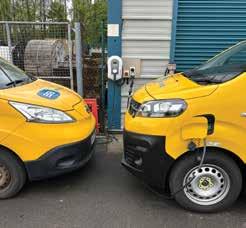
ESB Networks has long been to the fore in the transition towards electric vehicles. As far back as 2012 the first set of electric powered vans were put into operation, namely Ford Transit Edisons converted by English specialists Smith Electric. Since then around 75 Nissan eNV200 have been used successfully at each depot. Up to 200 electric vans have replaced diesel powered versions, with 75 kW opel, Fiat, Peugeot models
spotted in the compound on the day of the visit. These medium size vans provide up to 300km in range and offer a 1,000kg payload, which is sufficient, according to Martin Convey. There are 150 more electric vans on order at present.
Also on order are more MercedesBenz and Volvo 4x4 rigid trucks, but these are diesel powered as the electric technology available at HGV levelmeans such vehicles do not currently meet ESB Networks’ particular speciality needs.
“our electric vehicles (EVs) are used mainly by depot-based stores staff plus some metering NTs and predominantly by station staff where the range and payload requirements are suitable,” explained James. “To implement EVs on a more widespread basis will require us to address many challenges to ensure that ESB Networks can continue to serve its customers in the same manner.”
James further outlined these challenges which range from:
n Driver behaviour and driver adoption.
n Utilisation of Verizon telematics data.
n Range matching to ICE vehicle.
n Payload.
n Fitout.
n Smart Charging solutions.
Martin Convey (who, as an aside was a former winner of the Technician of the Year prize at the Fleet Transport Awards), outlined the company’s overall strategy, which primarily covers vehicles and charging. “A threefold strategic approach is required to successfully decarbonise our fleet,” he explained. “This includes the following areas:
n We rely on the market to have a selection of suitable electric or other zero emission vehicles available.
n our strategy here is to maximise early availability of suitable vehicles by engaging with vehicle manufacturers, identify suitable oEM produced electric vehicles or other zero emission vehicles that can be used in trials as early as possible.
n We will continually test the market with electric vehicle framework tenders which will enable us to buy EVs in larger numbers.
n We will work with the business and manufacturers to develop lightweight fit-outs that will maximise range, reduce payload and improve overall
energy efficiency of the vehicle.
n We will also look for opportunities to reduce the weight of equipment being carried in the vehicle.
n To successfully accommodate a large number of EVs on our fleet we will look at a number of options around the battery charging infrastructure. These include:
n Depot Charging – Roll out of fast charging (50kW DC) across most depots.
n Mobile on-site charging.
n Home Charging – Availability of home charging service for some staff that park ESB vehicles at their premises.
n Third Party Charging – Access to public charging infrastructure including fast charging for ESB Networks fleet. (1,350 e-Cars charge points across 750 locations).”

Martin explained that a number of these installations are already in situ, as seen at the Athlone facility. Solar panels to generate some naturally sourced electricity is also being considered.
A B ou T es B Ne TWo RK s ESB Networks is the licensed operator of the electricity distribution system in Ireland, including all distribution stations, overhead electricity lines, poles and underground cables, and is responsible for building, operating, and maintaining these to serve 2.3 million electricity customers across the country. ESB Networks also installs and maintains its own metering system. o ver the past decade, more than €6 billion has been invested to ensure a reliable service, meeting the needs of communities and businesses in Ireland.

